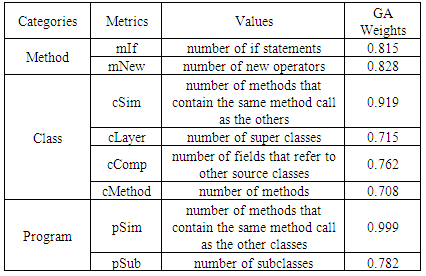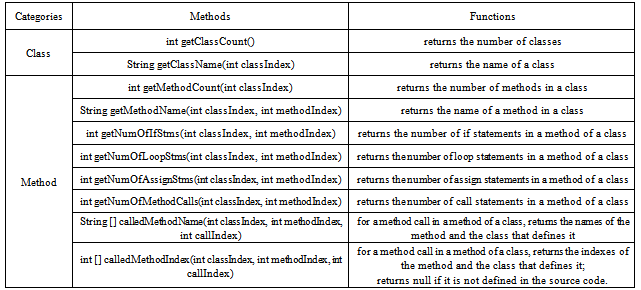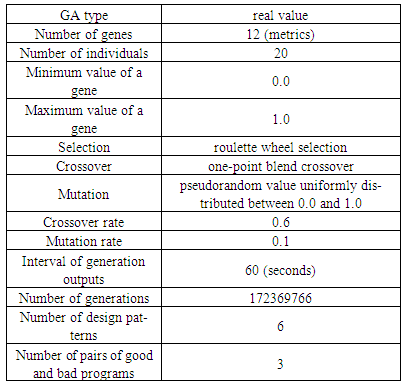-
Paper Information
- Paper Submission
-
Journal Information
- About This Journal
- Editorial Board
- Current Issue
- Archive
- Author Guidelines
- Contact Us
Software Engineering
p-ISSN: 2162-934X e-ISSN: 2162-8408
2012; 2(2): 29-35
doi:10.5923/j.se.20120202.03
GA-driven Automatic Refactoring based on Design Patterns
Takao Shimomura
Dept. of Information Science and Intelligent Systems, University of Tokushima, Tokushima, 770-8506, JAPAN
Correspondence to: Takao Shimomura, Dept. of Information Science and Intelligent Systems, University of Tokushima, Tokushima, 770-8506, JAPAN.
| Email: |  |
Copyright © 2012 Scientific & Academic Publishing. All Rights Reserved.
Refactoring is a process of applying behavior-preserving transformations to improve the design, readability, structure, performance, abstraction, and maintainability of existing code. This paper presents an approach to GA-driven refactoring for Java programs to automatically judge the qualities of programs based on design patterns. If a program is judged to be bad, this GA-driven refactoring method will further recommend that the program should be transformed using an appropriate design pattern.
Keywords: Design Patterns, Discriminant Analysis, Genetic Algorithm, Refactoring, Syntax Analysis
Cite this paper: Takao Shimomura, GA-driven Automatic Refactoring based on Design Patterns, Software Engineering, Vol. 2 No. 2, 2012, pp. 29-35. doi: 10.5923/j.se.20120202.03.
Article Outline
1. Introduction
- Refactoring is a process of applying behavior-preserving transformations to improve the design, readability, structure, performance, abstraction, and maintainability of existing code[1-3]. It applies some transformations to programs such as extracting interface for re-routing the access to a class via a newly created interface and pulling up members for moving members into a superclass. Griffith, et al.[4] developed an automated system utilizing Evolutionary Algorithms to manipulate refactorings correctly without requiring an underlying understanding of the software.Briand et al.[5] empirically explore the relationships between existing object-oriented coupling, cohesion, and inheritance measures and the probability of fault detection in system classes during testing. The frequency of method invocations and the depth of inheritance hierarchies seem to be the main driving factors of fault-proneness. Daikon[6] demonstrates the feasibility of automatically finding places in the program that are candidates for specific refactorings. The approach uses program invariants: when a particular pattern of invariant relationships appears at a program point, a specific refactoring is applicable. Hanenberg et al.[7] introduce a number of new aspect-oriented refactorings which help to migrate from object-oriented to aspect-oriented software and to restructure existing aspect-oriented code. Hannemann et al.[8] introduce a role-based refactoring approach to aid developers in re-structuring the implementation of crosscutting concerns using aspect-oriented programming. Tip et al.[9] present an approach in which type constraints are used to verify preconditions and to determine allowable source code modifications for a number of generalization-related refactorings. As object-oriented class libraries evolve, classes are occasionally deprecated in favor of others with roughly the same functionality. In Java's standard libraries, for example, class Hashtable has been superseded by HashMap, and Iterator is now preferred over Enumeration. Balaban et al.[10] present an approach in which mappings between legacy classes and their replacements are specified by the programmer. Then, an analysis based on type constraints determines where declarations and allocation sites can be updated. A variety of metrics have been proposed to estimate the qualities of programs[11,12]. For example, a class situated deeper in the inheritance hierarchy is more likely to be fault-prone than a class situated higher up (i.e., closer to the root) in the inheritance hierarchy. However, the cost of detecting candidates for refactoring and of choosing an appropriate refactoring transformation could be high. Genetic algorithm (GA) has been used to obtain the optimal solution in a variety of fields such as aesthetic design of bridge structures, logistics networks, and grid computing[13-15]. This paper presents an approach to GA-driven refactoring for Java programs to automatically judge the qualities of the programs based on design patterns[16]. If a program is judged to be bad, refactoring will be further recommended so that the program can be transformed using an appropriate design pattern.
2. GA-driven Refactoring
2.1. Design Patterns
- A design pattern is a general reusable solution to a commonly occurring problem in software design. If we appropriately apply design patterns to software development, we can efficiently make programs of high quality that can be easily enhanced. This GA-driven refactoring uses design patterns to judge a program to be bad if a design pattern can be applicable to the program. There are a number of design patterns, some of which are shown in Table 1. Abstract Factory design pattern can create a set of instances easily. Figure 1 shows two sample programs for the pattern. Figure 1 (a) illustrates a bad program to which the pattern can be applicable, and Fig. 1 (b) illustrates a good program that is obtained after the pattern is applied to the bad program. If the number of products is p, and the number of factories is f, the bad program requires the invocations of p*f new operations. On the other hand, the good program only requires the invocations of f create() methods. Template Method design pattern can customize a series of common processes partly. Figure 2 shows two sample programs for the pattern. Figure 2 (a) illustrates a bad program to which the pattern can be applicable, and Fig. 2 (b) illustrates a good program that is obtained after the pattern is applied to the bad program. If the number of classes that use a template method is c, and the number of sub-operations of the template method is s, the bad program requires c*s method invocations. On the other hand, the good program only requires c*t method invocations, where t is much less than s. Decorator design pattern can enhance a class without modifying the class. Figure 3 shows two sample programs for the pattern. Figure 3 (a) illustrates a bad program to which the pattern can be applicable, and Fig. 3 (b) illustrates a good program that is obtained after the pattern is applied to the bad program. If the number of components is c, and the number of decorators, which will enhance each component is d, the bad program requires c*d more classes. On the other hand, the good program only requires d more classes.
 | Figure 1. Sample programs for Abstract Factory |
 | Figure 2. Sample programs for Template Method |
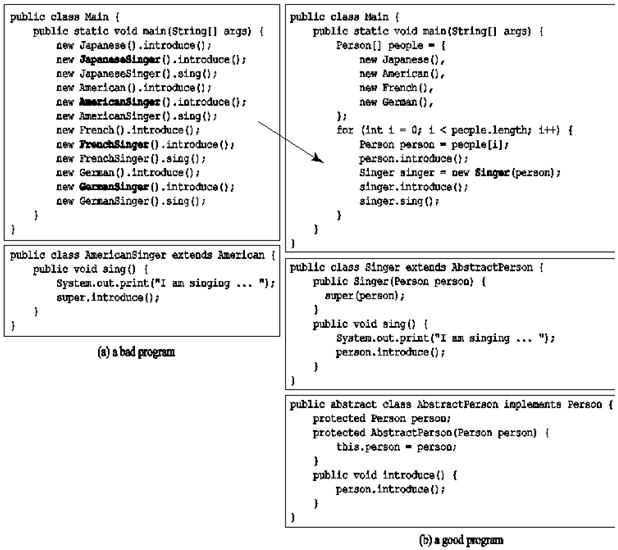 | Figure 3. Sample programs for Decorator |
2.2. Automatic Refactoring Flow
- Figure 4 shows a flow of GA-driven automatic refactoring. (1) First, for each design pattern, we make bad sample programs to which the design pattern should be applied. Then, we make good programs by applying the design pattern to each of them. (2) Then, the system read these bad and good programs to obtain a quality criterion with which a target program will be judged to be bad or good. The quality criterion is obtained based on the metrics of the bad and good programs. A genetic algorithm is used to determine the weight of each metric, which indicates how much impact the metric has to distinguish bad programs from good programs. (3) A target program is judged to be good or bad based on the obtained quality criterion. (4) If the target program is judged to be bad, the system will recommend design patterns applicable to the target program.
|
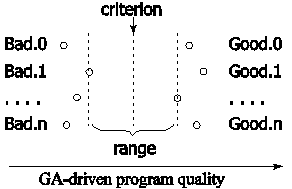 | Figure 5. Determine the criterion of program quality |
 | Figure 6. GA-driven discriminant analysis of program quality |
2.3. Metrics and Their Weights
- We introduce some metrics of a program to estimate its quality. These metrics are expected to become important factors that determine the quality of the program. However, it is not easy to judge whether each metric will have a good or bad influence on the program quality. Moreover, it is not easy to estimate to what extent each metric will give an impact to the program quality. Therefore, we introduce a weight for each metric, and define a factor as the value of a metric multiplied by some weight. Table 2 shows an example of some metrics of a program. For example, metric mIf is a factor that is derived from the number of if statements. The program quality of a program that consists of multiple source files will be calculated from the class qualities of the classes defined in the program. The class quality of a class will be calculated from the method qualities of the methods defined in the class.The value of a metric (m) is normalized to range from 0.0 to 1.0. For example, the normalized value of metric mIf is defined as1 - (1- mIf) / (1 + steps)where steps indicates the number of lines of program code in a method. A weight (w) also ranges from 0.0 to 1.0. A weight indicates to what extent each metric will give an impact to the program quality. When a metric (m) is introduced, we also introduce its dual metric (md) because we cannot know in advance whether the metric will have a good or bad influence on the program quality. The dual metric md of a metric m is defined as (1 - m). A factor (f) is defined as f = (m * w) + md * (1 - w)which ranges from 0.0 to 1.0. Each weight will be determined by a genetic algorithm as described in Section 2.4. If weight w becomes close to 1.0, a metric m will become an important factor. If weight w becomes close to 1/2, neither of metric m nor dual metric md will have an impact on program qualities. If weight w becomes close to 0.0, a dual metric md will become an important factor.
2.4. Determine the Criterion of Program Quality
- To define the quality of a program, we need to determine the weight of each metric. We do not have any preconception about the metrics we have introduced. Therefore, we determine the weight of each metric by using a genetic algorithm. To automatically determine the weights, we need to give some information about which program has a high quality and which program has a poor quality to the genetic algorithm. We have made some programs of high and poor qualities based on several design patterns, such as Abstract Factory, Template Method, and Decorator patterns. For example, in an Abstract Factory pattern, bad programs require more conditional statements than good programs. In a Template Method pattern, bad programs have some classes, where a method contains a sequence of the same method calls as a method another class defines. In a Decorator pattern, bad programs have more pairs of a superclass and a subclass and more instantiations than good programs. The genetic algorithm program calculates the program qualities of both of good and bad programs. Its fitness function returns a range (min{good programs' qualities} - max{bad programs' qualities}), as shown in Fig. 5. The optimal weights are determined so that this range will be as large as possible. We take the middle point as a criterion to judge whether a program has a good or bad quality. If the quality of a program that is calculated with the optimal weights is less than the criterion, this program will be judged to be a bad program, and refactoring is recommended so that the program will be transformed using an appropriate design pattern.
2.5. GA-Driven Discriminant Analysis
- Figure 6 illustrates a sequence of processes from collecting metrics to judging program qualities.(1) We first prepare several pairs of good and bad programs based on design patterns. Then, we execute MetricRefactor program to compile them and collect metrics.(2) We execute QualityGA program, which is a genetic algorithm program, to calculate the optimal weights of the metrics. It first reads the metrics that are output by MetricRefactor program. By using the fitness function described before, it determines the optimal weights of the metrics and periodically outputs them into a quality criterion file. This file contains the criterion to judge the quality of a program as well as a set of the optimal weights of the metrics. (3) If we execute QualifyRefactor program by specifying a target program, it will read the latest quality criterion file to calculate the quality of the target program and finally judge whether it is a good or bad program. Both of MetricRefactor and QualifyRefactor programs collect the metrics of a program. The way to collect metrics from a program will be described in detail in Section 3.
2.6. Recommendation of Applicable Design Patterns
- If the target program is judged to be bad, the system will recommend design patterns that are most applicable to the target program. Figure 7 shows how applicable design patterns are determined. Each bad program Bad.i.dp represents a point (mi*wi) in a multi-dimensional affine space of metrics, where mi is a metric and wi is its weight. If the target program is located most close to Bad.i.dp, its design pattern dp will be recommended. More than one design patterns can also be recommended.
3. Refactoring Analysis
3.1. Collecting Metrics by Using Java Compiler Visitor Pattern
- We have revised a Java compiler to collect metrics from a source program. The Java compiler is developed by using Visitor design pattern[16] so that its abstract syntax tree can be traversed without modifying the nodes of the syntax tree. Therefore, we have inserted some code to start traversing the syntax tree after compilation. Figure 8 shows a mechanism to compile a program and get metrics.
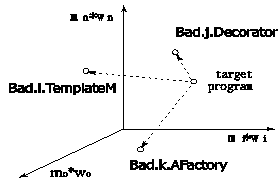 | Figure 7. Recommendation of applicable design patterns |
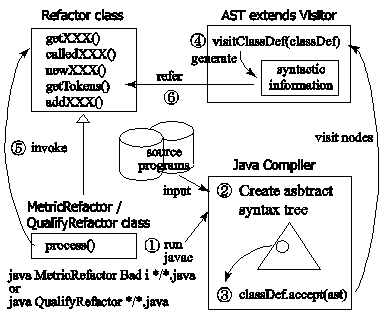 | Figure 8. Collecting metrics by using the Visitor pattern of Java compiler |
|
3.2. Calculation of Program Qualities Using the methods of Refactor Superclass
- Table 3 shows an example of methods provided by Refactor class. Because both of MetricRefactor and QualifyRefactor classes are Refactor subclasses, they can directly invoke these methods to collect metrics. For example, if we use calledMethodIndex(int classIndex, int methodIndex, int callIndex), we can know about each method call contained in a method definition of a class, including whether the invoked method is defined in the source code or not.
4. Observation
|
5. Conclusions
- This paper has presented an approach to discriminate between programs of high and poor qualities by using a genetic algorithm based on design patterns. Like corpuses in the natural language processing, we need to collect more samples for bad and good programs. At present, this system uses one-dimensional quality. We intend to classify some metrics into groups and apply multivariate analysis.
 Abstract
Abstract Reference
Reference Full-Text PDF
Full-Text PDF Full-text HTML
Full-text HTML

